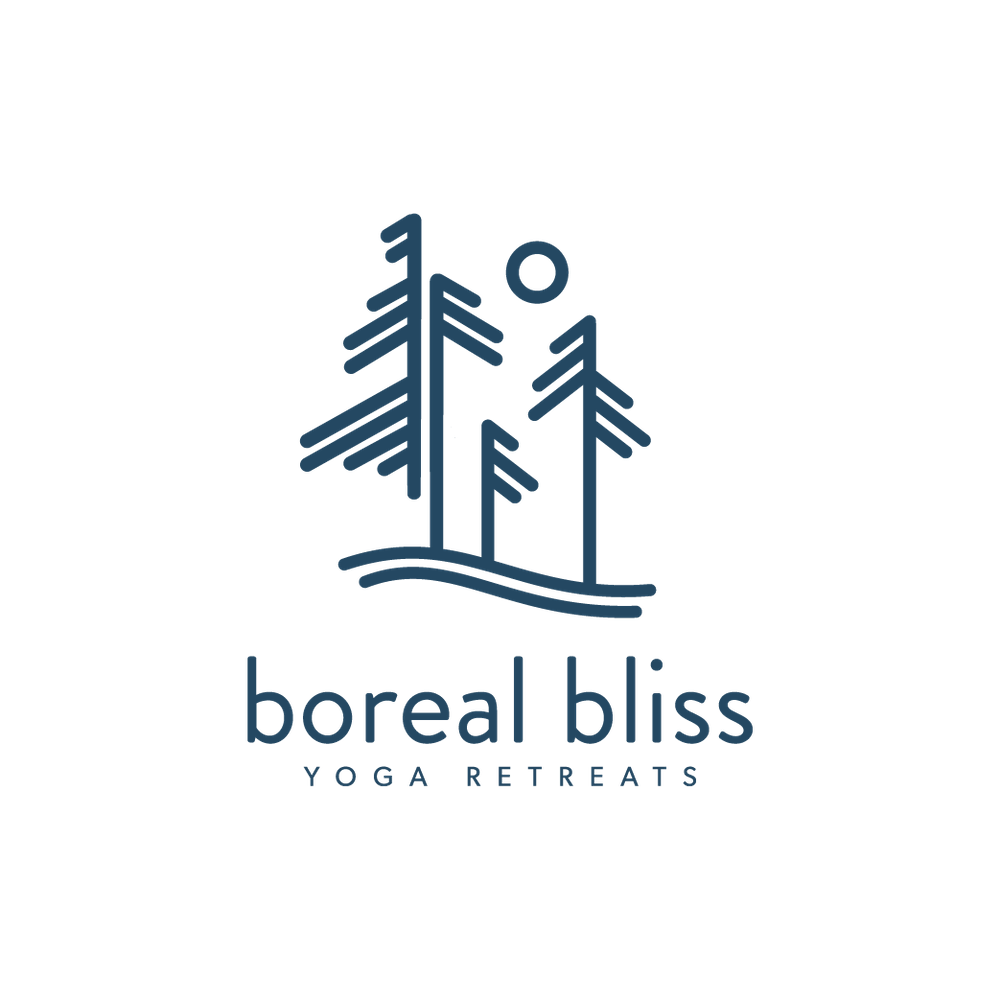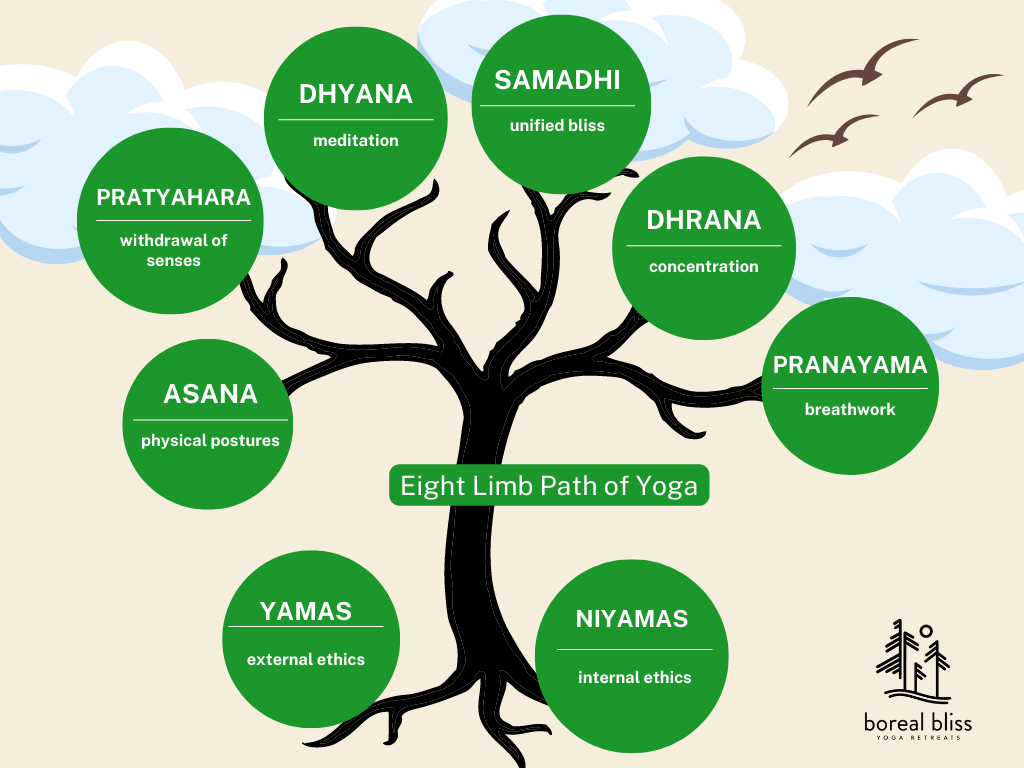Practical Application of the Eight Limb Path of Yoga
Yoga has a way of making us feels so wonderful. But what is it? Is it poses on a yoga mat? Is it meditation? Is it relaxation?
Yoga is the combination of many things! Ultimately yoga comes from the sanskrit word yuj, which translates as “to yoke” and/or unity. A unification of mind, body, spirit. Anything that strays from unity and inclusion technically wouldn’t be yoga.
Photo by Ashley Bredemus
Yoga is more than physical postures on a yoga mat. It’s a system and approach to life.
“Patanjali’s eight-limb path” is translated from the Yoga Sutras from the word Ashtanga (asha - eight, tanga- limb). The eight limbs of yoga act as guidelines to achieve samadhi, ultimate unified bliss, as well as how to live a meaningful life.
Applying the Eight Limb Path
The eight limb path can ultimately be seen as a pathway to samadhi, or bliss. Following the eight limbs “in order” is typically a less frustrating way. But it’s not always necessary, and the order is more nuanced than meets the eye. One can envision a tree, and think of the yamas & niyamas as the roots or foundation. Then climbing up each limb we apply asana, pranayama, pratyahara, dhrana, dhyana, and then samadhi.
For example, you cannot achieve dhyana, meditation without pratyahara, withdrawal of the senses. Often in our modern world we need to incorporate asana, physical postures and breathing practices, pranayama to settle the mind prior to that. And if you are not living in line with your morals and values (yamas & niyamas), how can you come to a settled and peaceful state of union with your truest Self? This process may take 5-10 minutes, or a lifetime, depending on where you are at in your yoga journey.
The eight limbs of yoga are:
Yamas
Ones ethical standards, values, and sense of integrity.
External ethics, aka social restraints/moral codes: i.e. golden rule “do unto others as you would have them do unto you”.
The Five Yamas
Ahimsa (non-violence)
Satya (truthfulness)
Asteya (non-stealing)
Brahmacharya (non-excess)
Aparigraha (non-possessiveness/lack of greed)
Niyamas
Self-discipline and spiritual observance.
Internal ethics, aka observances, values, and guidelines for oneself.
The Five Niyamas
Saucha (cleanliness)
Santosha (contentment)
Tapas (heat; self-discipline)
Svadhyaya (self-study)
Isvara Pranidhana (surrender to God/higher power/Self/choice of spirituality)
Asana
Physical postures practiced and studied in yoga.
What we have come to know in the West as a typical yoga class.
Fun fact: there are so many different styles and types of yoga asana - I could not even begin to know them all! It’s fun to explore and find the right fit for you. And sometimes throughout life that “right fit” changes. Yoga asana changes with you and that’s what of the main things I love about it.
Pranayama
Breathing practice or breath control.
Practicing breathwork in and of itself is powerful for many - combine it with yoga asana and voila! Magic.
Recognizing the connection between breath, mind, and emotions.
Translates to “life force”.
Pratyahara
To withdraw from the senses.
Removing the clutter, busyness, multi-tasking, over-stimulus, and go-go-go lifestyle.
Dharana
Development of concentration.
Concentrating with focus in meditation or asana: drishti.
Dhyana
Meditation or contemplation.
Being aware without focus. Quiet, silent meditation.
Samadhi
State of ultimate bliss.
Profound connection to the divine (or connection to your personal choice of spirituality).
At one with the universe or Self.
Photo: Sarah Miller, Whispering Willow Photography
Eight Limb Path Applied at a Boreal Bliss Yoga Retreat
You can plainly see elements of the eight-limb path play-out in a Boreal Bliss style retreat or training in many different ways. However, some of the implementation of the eight-limb path are not as obvious. Ultimately at Boreal Bliss Yoga Retreats, we want you to feel well, vibrant, connected to nature, and authentically true to yourself. To us that means giving you options, agency over your own choices, and space to discover what is best for you.
The yamas and niyamas are the foundation of living a yoga lifestyle. Living with ethics and aligning with one’s values is an example of this. Helping individuals explore what this means to them through writing prompts is often how we incorporate this.
Asana is an obvious application at a yoga retreat: we offer several yoga classes over a retreat weekend that include the physical practice of yoga.
Pranayama, breathwork is an element that is always incorporated into every yoga class we offer. Quiet moments connected to intentional breathing is powerful.
We have found that the practice of pratyahara, withdrawal of the senses, is key in helping an individual truly tap into a mindful state. When we step away from the busyness and overload of the senses of everyday life, we find that we are able to access a level of our yoga practice that we typically cannot achieve at home. Immersion at a retreat is a powerful practice of pratyahara.
Dharana, development of concentration is more difficult (or impossible) without the practice of pratyahara. That is why dharana comes after withdrawal of the sense (pratyahara)! This is often offered in the form of specific focus during a physical practice of yoga asana as you intentionally focus your gaze (ie. drishti), such as head to knee pose when focusing intentionally on your knee. This is also practiced through guided meditation, candle meditation, sound bowls, hiking meditation (or mindfulness walk). Mindfully focus on what’s in front of you (literally and figuratively) and you are practicing dharana.
Dhyana is deep concentration or meditation. A meditative practice without a singular focus/goal. You feel fully immersed and experience a sensation of oneness. This is often a meditation practiced seated in silence.
Samadhi is a blissful feeling where you feel connected to your most authentic self. Yoga means “to yoke” or experience union. You are at one with your mind, body, soul and the universe. This is a sensation of enlightenment. This is often associated with a deep, connected silent meditation experience. But we have more to explore on this as you keep reading…
ultimately, Yoga is More than Poses on a Mat
You may feel samadhi (bliss) personally from a yoga practice, a silent solo hike in the woods, a snowy cross country ski, gazing at the trees from a hammock, canoeing in the boundary waters, or floating in a lake. There are ways to achieve this sensation other than a practice on your yoga mat or traditional meditation. Why? Because yoga is an eight-limb practice and does not necessarily involve the “yoga poses” on a yoga mat that you’ve come to know. It almost certainly always involves mindful, feel-good movement though.
If you’d like to incorporate a recipe that has been practiced for thousands of years, and is totally customizable to your needs and beliefs - work on including all elements of the 8-Limb Path of Yoga in your life.
But one last word on yoga poses…
Ok..the yoga poses on the mat are pretty powerful and compelling, aren’t they? I spend a lot of time “convincing” other people and those in our yoga teacher training program that yoga is more than asana, but then in the same token I do believe wholeheartedly that asana is incredible. There’s something about the physical postures that certainly hold the magic in the recipe of the 8-limb path. Why else would so many people be just as fascinated in it? So yes, incorporate yoga asana in your life, but maybe consider how you are bringing in the other elements of yoga too.
If you’d like to read and learn more about the framework, here are a few of the books we love:
The Yamas & Niyamas: Exploring Yoga’s Ethical Practice by Deborah Adele (*she’s an author from Duluth, MN!)
Embrace Yoga’s Roots: Courageous Ways to Deepen Your Yoga Practice by Susanna Barkataki
Yoga: Ancient Heritage, Tomorrow’s Vision by Indu Arora
Photo by Rohana Olson












